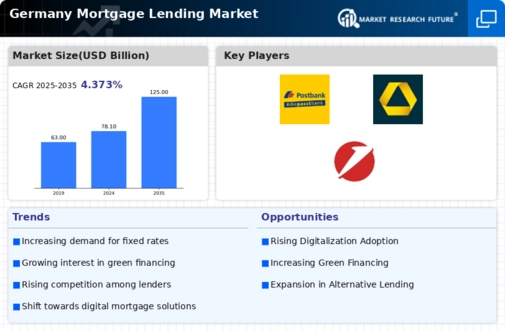The Germany Mortgage Lending Market is characterized by a robust competitive landscape that reflects the unique dynamics of the country's economic environment. The market is driven by several factors, including fluctuating interest rates, changing consumer preferences for home ownership, and an evolving regulatory framework.
Competitive insights reveal that key players are increasingly leveraging technology and digital platforms to enhance customer engagement and streamline their lending processes. Additionally, various banks and financial institutions are focusing on offering tailored mortgage products that cater to diverse borrower needs, positioning themselves favorably in the rapidly changing market landscape.The emergence of fintech firms is further intensifying competition, driving traditional banks to innovate and refine their service offerings to retain their market share and attract new customers.
INGDiBa, known for its strong digital banking presence, has carved out a significant niche within the Germany Mortgage Lending Market. The company boasts a user-friendly online platform that facilitates mortgage applications, ensuring a seamless experience for customers looking to secure financing for their homes.Its strengths lie in its transparent fee structure, competitive interest rates, and a wide variety of mortgage products tailored to different customer needs, from first-time buyers to those looking to refinance existing loans.
INGDiBa has established a reputation for exceptional customer service and satisfaction, further solidifying its position within the mortgage lending sector. As a subsidiary of a larger international banking group, it benefits from a strong financial foundation, enabling it to offer attractive lending options to German consumers.
HypoVereinsbank represents a significant player in the German Mortgage Lending Market, providing a comprehensive suite of mortgage products and services designed to meet the needs of a varied clientele. It offers fixed-rate mortgages, variable-rate options, and specialized loans for energy-efficient home purchases, ensuring it can address diverse borrower requirements.
With a solid market presence, HypoVereinsbank leverages its long-standing history and brand equity to foster trust among consumers. Its recent focus on digital innovations has streamlined the mortgage application process, allowing for quicker approvals and enhanced customer interactions.
The company has also engaged in strategic mergers and acquisitions to bolster its offerings and expand its market reach, thus continuously enhancing its capabilities within the competitive landscape of Germany’s mortgage lending sector. These efforts underscore HypoVereinsbank's commitment to providing tailored solutions while maintaining a competitive edge against emerging players in the market.




